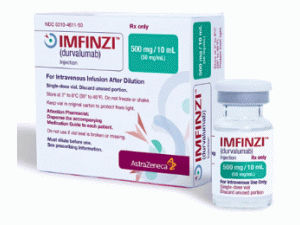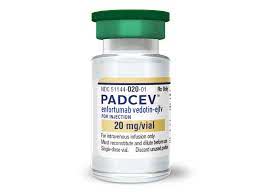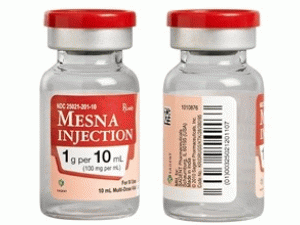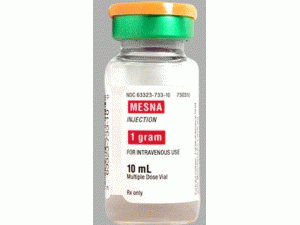度伐单抗注射剂Imfinzi injection 50mg/ml 10ml(durvalumab)
 药店国别:
产地国家:美国
处方药:是
所属类别: 50毫克/毫升 10毫升/瓶
包装规格: 50毫克/毫升 10毫升/瓶
计价单位:瓶
生产厂家中文参考译名:
生产厂家英文名:AstraZeneca
原产地英文商品名:IMFINZI 50MG/ML 10ML SDV AZ 1/EA
原产地英文药品名:Durvalumab
中文参考商品译名:IMFINZI注射溶液 50毫克/毫升 10毫升/瓶
中文参考药品译名:度伐单抗
曾用名:
简介:近日,美国食品和药物管理局批准加速批准IMFINZI(durvalumab)治疗局部晚期或转移性尿路上皮癌患者,在铂类化疗期间或之后患有疾病进展或患有新辅助或辅助治疗12个月内用含铂化疗治疗疾病进展。Durvalumab是一种程式死亡配体1(PD-L1)阻断抗体,程式细胞死亡配体-1(PD-L1)的表达可能被炎症信号诱导(如,IFN-gamma),和可能被表达在肿瘤细胞和在肿瘤微环境中肿瘤-关联免疫细胞上。PD-L1阻断T-细胞功能以及通过PD-1和CD80(B7.1)
作用相互活化
通过结合至它的受体,PD-L1减低细毒性T-细胞的活性,增殖,和细胞因数的产生。在同种移植的人类肿瘤和免疫细胞异种移植小鼠模型中,durvalumab阻断PD-L1能增加T-细胞的活化作用,减低肿瘤大小。批准日期:2017年5月1日公司:阿斯利康公司IMFINZI(durvalumab)注射液,用于静脉注射美国最初批准:2017年最近的重大变
警告和注意事项:
02/2018作用机制程序性细胞死亡配体-1(PD-L1)的表达可以由炎性信号(例如,IFN-γ)诱导,并且可以在肿瘤微环境中的肿瘤细胞和肿瘤相关免疫细胞上表达。PD-L1通过与PD-1和CD80的相互作用阻断T细胞功能和活化(B7.1)。通过与其受体结合,PD-L1降低细胞毒性T细胞活性,增殖和细胞因子产生。Durvalumab是一种人免疫球蛋白G1kappa(IgG1κ)单克隆抗体,可与PD-L1结合并阻断PD-L1与PD-1和CD80的相互作用(B7.1)。阻断PD-L1/PD-1和PD-L1/CD80相互作用释放免疫应答的抑制,而不诱导抗体依赖性细胞介导的细胞毒性(ADCC)。使用durvalumab的PD-L1阻断导致体外T细胞活化增加并且共同移植的人肿瘤和免疫细胞异种移植小鼠模型中的肿瘤尺寸减小。
适应症和用法
IMFINZI是一种程序性死亡配体1(PD-L1)阻断抗体,用于治疗患者:•局部晚期或转移性尿路上皮癌:o在含铂化疗期间或之后有疾病进展。o在使用含铂化疗的新辅助治疗或辅助治疗的12个月内有疾病进展。根据肿瘤反应率和反应持续时间,在加速批准下批准该适应症。持续批准该适应症可能取决于确认试验中的临床益处的验证和描述。•无法切除的III期非小细胞肺癌(NSCLC),其并发铂类化疗和放射治疗后疾病未发展。
剂量和给药
•尿路上皮癌:每2周10mg/kg。•III期NSCLC:每2周10mg/kg。剂量形式和强度•注射:500mg/10mL(50mg/mL)溶液,单剂量小瓶。•注射:单剂量小瓶中的120mg/2.4mL(50mg/mL)溶液。
禁忌症
没有。
警告和注意事项
•免疫介导的肺炎:对于严重或危及生命的肺炎,中度和永久性停用。•免疫介导的肝炎:监测肝功能的变化。对于严重或危及生命的转氨酶或总胆红素升高的中度和永久性停用。•免疫介导的结肠炎:对于严重或危及生命的结肠炎,保留中度和永久性停药。•免疫介导的内分泌病:适用于中度,重度或危及生命的疾病。•免疫介导的肾炎:监测肾功能的变化。对于严重或危及生命的肾炎,暂停中度和永久性停药。•免疫介导的皮肤病学反应:对于严重或危及生命的皮疹,中度和永久性停药。•感染:保留严重或危及生命的感染。•输液相关反应:中度或减慢轻度或中度输注速度,并对严重或危及生命的输液相关反应永久停药。•胚胎- 胎儿毒性:可能导致胎儿伤害。告知女性有可能对胎儿造成潜在风险并使用有效避孕措施。
不良反应
•最常见的不良反应(≥15%的尿路上皮癌患者)是疲劳,肌肉骨骼疼痛,便秘,食欲减退,恶心,外周性水肿和尿路感染。•最常见的不良反应(≥20%无法切除的III期NSCLC患者)为咳嗽,疲劳,肺炎/放射性肺炎,上呼吸道感染,呼吸困难和皮疹。
用于特定人群哺乳期:
建议不要母乳喂养。包装提供/存储和处理IMFINZI(durvalumab)注射液是一种透明的乳白色,无色至微黄色溶液,装在一个装有一个单剂量小瓶的纸箱中,如下:•500毫克/10毫升(NDC
0310-4611-50)•120毫克/2.4毫升(NDC0310-4500-12)使用原装纸箱存放在2°C至8°C(36°F至46°F)的冰箱中,以防光照。不要冻结。别摇了。
度伐单抗注射剂英文版说明书
Imfinzi will be available in single-dose vials in 500mg/10mL or 120mg/2.4mL strengthsPD-L1 expression: The role of programmed cell death ligand-11Expression of programmed cell death ligand-1 (PD-L1) can be induced by inflammatory signals (eg, IFN-gamma) and can be expressed on both tumor cells and tumor-associated immune cells in tumor microenvironment. PD-L1 blocks T-cell function and activation through interaction with PD-1 and CD80 (B7.1). By binding to its receptors, PD-L1 reduces cytotoxic T-cell activity, proliferation, and cytokine production.Although testing is not required, knowing your patient's PD-L1 expression status may aid in treatment selection and help manage patientIMFINZI mechanism of action1Durvalumab is a human immunoglobulin G1 kappa (IgG1κ) monoclonal antibody that blocks the interaction of PD-L1 with PD-1 and CD80 (B7.1). Blockade of PD-L1/PD-1 and PD-L1/CD80 interactions releases the inhibition of immune responses, without inducing antibody dependent cell-mediated cytotoxicity (ADCC).PD-L1 blockade with durvalumab led to increased T-cell activation in vitro and decreased tumor size in co-engrafted human tumor and immune cell xenograft mouse models.Important Safety InformationThere are no contraindications for IMFINZITM (durvalumab).Monitor patients for clinical signs and symptoms of immune-mediated pneumonitis, hepatitis, colitis or diarrhea, endocrinopathies, nephritis, rash or dermatitis, and other immune-mediated adverse reactions. Please refer to the full Prescribing Information for important dose management information specific to adverse reactions.Immune-Mediated PneumonitisIn the combined safety database (n=1414), immune-mediated pneumonitis occurred in 32 patients (2.3%), including 1 fatal case (0.1%) and 6 Grade 3–4 cases (0.4%). In Study 1 (n=182), 1 patient (0.5%) died from immune-mediated pneumonitis. Monitor patients for signs and symptoms of pneumonitis and eva luate with radiographic imaging when suspected. Administer corticosteroids for ≥Grade 2 pneumonitis. Withhold IMFINZI for Grade 2 pneumonitis; permanently discontinue for Grade 3–4 pneumonitis.Immune-Mediated HepatitisIn the combined safety database (n=1414), immune-mediated hepatitis occurred in 16 patients (1.1%), including 1 fatal case (<0.1%) and 9 Grade 3 cases (0.6%). Grade 3–4 elevations in ALT occurred in 40/1342 patients (3.0%), AST in 58/1336 patients (4.3%), and total bilirubin in 37/1341 patients (2.8%). In Study 1 (n=182), 1 patient (0.5%) died from immune-mediated hepatitis, and 2 patients (1.1%) experienced immune-mediated hepatitis, including 1 Grade 3 case (0.5%). Monitor patients for abnormal liver tests in each cycle during treatment with IMFINZI. Administer corticosteroids and withhold IMFINZI for Grade 2–3 ALT or AST >3–5X ULN or ≤8X ULN or total bilirubin >1.5–3X ULN or ≤5X ULN. Permanently discontinue IMFINZI in patients with Grade 3 ALT or AST >8X ULN or total bilirubin >5X ULN, or in patients with concurrent ALT or AST >3X ULN and total bilirubin >2X ULN with no other cause.Immune-Mediated ColitisIn the combined safety database (n=1414), immune-mediated colitis or diarrhea occurred in 18 patients (1.3%), including 1 Grade 4 case (<0.1%) and 4 Grade 3 cases (0.3%). In Study 1 (n=182), 23 patients (12.6%) experienced colitis or diarrhea, including 2 Grade 3–4 cases (1.1%). Monitor patients for signs and symptoms of colitis or diarrhea. Administer corticosteroids for ≥Grade 2 colitis or diarrhea. Withhold IMFINZI for Grade 2 colitis or diarrhea; permanently discontinue for Grade 3–4 colitis or diarrhea.Immune-Mediated EndocrinopathiesImmune-mediated thyroid disorders, adrenal insufficiency, type 1 diabetes mellitus and hypophysitis/hypopituitarism have occurred with IMFINZI. Monitor patients for clinical signs and symptoms of endocrinopathies. For Grade 2–4 endocrinopathies (except hypothyroidism) withhold dose until clinically stable and offer symptomatic management for hyperthyroidism. For Grade 2–4 hypothyroidism, initiate thyroid hormone replacement as neededImmune-mediated hypothyroidism and hyperthyroidism—In the combined safety database (n=1414), immune-mediated hypothyroidism and hyperthyroidism occurred in 136 patients (9.6%) and 81 patients (5.7%), respectively. Thyroiditis occurred in 10 patients (0.7%), including 1 Grade 3 case (<0.1%) in a patient who had a myocardial infarction. In 9 patients with thyroiditis, transient hyperthyroidism preceded hypothyroidism. In Study 1 (n=182), Grade 1–2 hypothyroidism or thyroiditis occurred in 10 patients (5.5%). Grade 1–2 hyperthyroidism or thyroiditis leading to hyperthyroidism occurred in 9 patients (4.9%). Monitor patients for abnormal thyroid function tests prior to and periodically during treatmentImmune-mediated adrenal insufficiency—In the combined safety database (n=1414), immune-mediated adrenal insufficiency occurred in 13 patients (0.9%), including 2 Grade 3 cases (0.1%). In Study 1 (n=182), Grade 1 adrenal insufficiency occurred in 1 patient (0.5%). Administer corticosteroids and hormone replacement as clinically indicatedType 1 diabetes mellitus—In the combined safety database (n=1414), new onset type 1 diabetes mellitus without an alternative etiology occurred in 1 patient (<0.1%). For type 1 diabetes mellitus, initiate insulin as indicated and withhold IMFINZI until clinically stableHypophysitis—In the combined safety database (n=1414), hypopituitarism leading to adrenal insufficiency and diabetes insipidus occurred in 1 patient (<0.1%). Administer corticosteroids and hormone replacement as clinically indicatedOther Immune-Mediated Adverse ReactionsIMFINZI has caused immune-mediated rash. Other immune-related adverse reactions, including aseptic meningitis, hemolytic anemia, immune thrombocytopenic purpura, myocarditis, myositis, nephritis, and ocular inflammatory toxicity including uveitis and keratitis, have occurred in ≤1.0% of patients treated with IMFINZIImmune-mediated rash or dermatitis—In the combined safety database (n=1414), immune-mediated rash or dermatitis occurred in 220 patients (15.6%) and 4 patients (0.3%) developed vitiligo. In Study 1 (n=182), 20 patients (11.0%) developed rash, including 1 Grade 3 case (0.5%). Patients should be monitored for signs and symptoms of rash or dermatitis. Administer corticosteroids if indicated. Withhold IMFINZI for Grade 3 rash or dermatitis or Grade 2 rash or dermatitis lasting >1 week. Permanently discontinue IMFINZI in patients with Grade 4 rash or dermatitisImmune thrombocytopenic purpura—In the combined safety database (n=1414), 1 fatal case (<0.1%) of immune thrombocytopenic purpura occurred. Monitor patients for signs and symptoms of immune thrombocytopenic purpuraNephritis—In the combined safety database (n=1414), immune-mediated nephritis occurred in 3 patients (0.2%), including 2 Grade 3 cases (0.1%). Monitor patients for abnormal renal function tests prior to and during each cycle of IMFINZI. Administer corticosteroids for ≥Grade 2 nephritis (creatinine >1.5X ULN). Withhold IMFINZI for Grade 2 nephritis; permanently discontinue for ≥Grade 3 nephritis (creatinine >3X ULN)InfectionSevere infections, including sepsis, necrotizing fasciitis, and osteomyelitis, occurred in patients receiving IMFINZI. In the combined safety database (n=1414), infections occurred in 531 patients (37.6%). In Study 1 (n=182), infections occurred in 54 patients (29.7%). 11 patients (6.0%) experienced Grade 3–4 infection and 5 patients (2.7%) were experiencing infection at the time of death. 8 patients (4.4%) experienced urinary tract infection, the most common ≥Grade 3 infection. Monitor patients for signs and symptoms of infection and treat with anti-infectives for suspected or confirmed infections. Withhold IMFINZI for ≥Grade 3 infection.Infusion-Related ReactionsIn the combined safety database (n=1414), severe infusion-related reactions occurred in 26 patients (1.8%). In Study 1 (n=182), infusion-related reactions occurred in 3 patients (1.6%). There were 5 Grade 3 (0.4%) and no Grade 4 or 5 reactions. Patients should be monitored for signs and symptoms of infusion-related reactions. Interrupt or slow the rate of infusion for Grade 1–2 infusion-related reactions and permanently discontinue for Grade 3–4 infusion-related reactions.Embryo-Fetal ToxicityBased on its mechanism of action and data from animal studies, IMFINZI can cause fetal harm when administered to a pregnant woman. There are no data on the use of IMFINZI in pregnant women. Advise pregnant women of the potential risk to a fetus and advise women of reproductive potential to use effective contraception during treatment and for at least 3 months after the last dose of IMFINZI.Nursing MothersThere is no information regarding the presence of IMFINZI in human milk; however, because of the potential for adverse reactions in breastfed infants from IMFINZI, advise a lactating woman not to breastfeed during treatment and for at least 3 months after the last dose.Most Common Adverse ReactionsThe most common adverse reactions (≥15%) were fatigue (39%), musculoskeletal pain (24%), constipation (21%), decreased appetite (19%), nausea (16%), peripheral edema (15%), and urinary tract infection (15%). The most common Grade 3 or 4 adverse reactions (≥3%) were fatigue, urinary tract infection, musculoskeletal pain, abdominal pain, dehydration, and general physical health deteriorationAdverse reactions leading to discontinuation of IMFINZI occurred in 3.3% of patients. Serious adverse reactions occurred in 46% of patients. The most frequent serious adverse reactions (>2%) were acute kidney injury (4.9%), urinary tract infection (4.4%), musculoskeletal pain (4.4%), liver injury (3.3%), general physical health deterioration (3.3%), sepsis, abdominal pain, and pyrexia/tumor associated fever (2.7% each)The safety and effectiveness of IMFINZI have not been established in pediatric patients.Indications and UsageIMFINZI is indicated for the treatment of patients with locally advanced or metastatic urothelial carcinoma who:have disease progression during or following platinum-containing chemotherapyhave disease progression within 12 months of neoadjuvant or adjuvant treatment with platinum-containing chemotherapyThis indication is approved under accelerated approval based on tumor response rate and duration of response. Continued approval for this indication may be contingent upon verification and description of clinical benefit in confirmatory trials。
药店国别:
产地国家:美国
处方药:是
所属类别: 50毫克/毫升 10毫升/瓶
包装规格: 50毫克/毫升 10毫升/瓶
计价单位:瓶
生产厂家中文参考译名:
生产厂家英文名:AstraZeneca
原产地英文商品名:IMFINZI 50MG/ML 10ML SDV AZ 1/EA
原产地英文药品名:Durvalumab
中文参考商品译名:IMFINZI注射溶液 50毫克/毫升 10毫升/瓶
中文参考药品译名:度伐单抗
曾用名:
简介:近日,美国食品和药物管理局批准加速批准IMFINZI(durvalumab)治疗局部晚期或转移性尿路上皮癌患者,在铂类化疗期间或之后患有疾病进展或患有新辅助或辅助治疗12个月内用含铂化疗治疗疾病进展。Durvalumab是一种程式死亡配体1(PD-L1)阻断抗体,程式细胞死亡配体-1(PD-L1)的表达可能被炎症信号诱导(如,IFN-gamma),和可能被表达在肿瘤细胞和在肿瘤微环境中肿瘤-关联免疫细胞上。PD-L1阻断T-细胞功能以及通过PD-1和CD80(B7.1)
作用相互活化
通过结合至它的受体,PD-L1减低细毒性T-细胞的活性,增殖,和细胞因数的产生。在同种移植的人类肿瘤和免疫细胞异种移植小鼠模型中,durvalumab阻断PD-L1能增加T-细胞的活化作用,减低肿瘤大小。批准日期:2017年5月1日公司:阿斯利康公司IMFINZI(durvalumab)注射液,用于静脉注射美国最初批准:2017年最近的重大变
警告和注意事项:
02/2018作用机制程序性细胞死亡配体-1(PD-L1)的表达可以由炎性信号(例如,IFN-γ)诱导,并且可以在肿瘤微环境中的肿瘤细胞和肿瘤相关免疫细胞上表达。PD-L1通过与PD-1和CD80的相互作用阻断T细胞功能和活化(B7.1)。通过与其受体结合,PD-L1降低细胞毒性T细胞活性,增殖和细胞因子产生。Durvalumab是一种人免疫球蛋白G1kappa(IgG1κ)单克隆抗体,可与PD-L1结合并阻断PD-L1与PD-1和CD80的相互作用(B7.1)。阻断PD-L1/PD-1和PD-L1/CD80相互作用释放免疫应答的抑制,而不诱导抗体依赖性细胞介导的细胞毒性(ADCC)。使用durvalumab的PD-L1阻断导致体外T细胞活化增加并且共同移植的人肿瘤和免疫细胞异种移植小鼠模型中的肿瘤尺寸减小。
适应症和用法
IMFINZI是一种程序性死亡配体1(PD-L1)阻断抗体,用于治疗患者:•局部晚期或转移性尿路上皮癌:o在含铂化疗期间或之后有疾病进展。o在使用含铂化疗的新辅助治疗或辅助治疗的12个月内有疾病进展。根据肿瘤反应率和反应持续时间,在加速批准下批准该适应症。持续批准该适应症可能取决于确认试验中的临床益处的验证和描述。•无法切除的III期非小细胞肺癌(NSCLC),其并发铂类化疗和放射治疗后疾病未发展。
剂量和给药
•尿路上皮癌:每2周10mg/kg。•III期NSCLC:每2周10mg/kg。剂量形式和强度•注射:500mg/10mL(50mg/mL)溶液,单剂量小瓶。•注射:单剂量小瓶中的120mg/2.4mL(50mg/mL)溶液。
禁忌症
没有。
警告和注意事项
•免疫介导的肺炎:对于严重或危及生命的肺炎,中度和永久性停用。•免疫介导的肝炎:监测肝功能的变化。对于严重或危及生命的转氨酶或总胆红素升高的中度和永久性停用。•免疫介导的结肠炎:对于严重或危及生命的结肠炎,保留中度和永久性停药。•免疫介导的内分泌病:适用于中度,重度或危及生命的疾病。•免疫介导的肾炎:监测肾功能的变化。对于严重或危及生命的肾炎,暂停中度和永久性停药。•免疫介导的皮肤病学反应:对于严重或危及生命的皮疹,中度和永久性停药。•感染:保留严重或危及生命的感染。•输液相关反应:中度或减慢轻度或中度输注速度,并对严重或危及生命的输液相关反应永久停药。•胚胎- 胎儿毒性:可能导致胎儿伤害。告知女性有可能对胎儿造成潜在风险并使用有效避孕措施。
不良反应
•最常见的不良反应(≥15%的尿路上皮癌患者)是疲劳,肌肉骨骼疼痛,便秘,食欲减退,恶心,外周性水肿和尿路感染。•最常见的不良反应(≥20%无法切除的III期NSCLC患者)为咳嗽,疲劳,肺炎/放射性肺炎,上呼吸道感染,呼吸困难和皮疹。
用于特定人群哺乳期:
建议不要母乳喂养。包装提供/存储和处理IMFINZI(durvalumab)注射液是一种透明的乳白色,无色至微黄色溶液,装在一个装有一个单剂量小瓶的纸箱中,如下:•500毫克/10毫升(NDC
0310-4611-50)•120毫克/2.4毫升(NDC0310-4500-12)使用原装纸箱存放在2°C至8°C(36°F至46°F)的冰箱中,以防光照。不要冻结。别摇了。
度伐单抗注射剂英文版说明书
Imfinzi will be available in single-dose vials in 500mg/10mL or 120mg/2.4mL strengthsPD-L1 expression: The role of programmed cell death ligand-11Expression of programmed cell death ligand-1 (PD-L1) can be induced by inflammatory signals (eg, IFN-gamma) and can be expressed on both tumor cells and tumor-associated immune cells in tumor microenvironment. PD-L1 blocks T-cell function and activation through interaction with PD-1 and CD80 (B7.1). By binding to its receptors, PD-L1 reduces cytotoxic T-cell activity, proliferation, and cytokine production.Although testing is not required, knowing your patient's PD-L1 expression status may aid in treatment selection and help manage patientIMFINZI mechanism of action1Durvalumab is a human immunoglobulin G1 kappa (IgG1κ) monoclonal antibody that blocks the interaction of PD-L1 with PD-1 and CD80 (B7.1). Blockade of PD-L1/PD-1 and PD-L1/CD80 interactions releases the inhibition of immune responses, without inducing antibody dependent cell-mediated cytotoxicity (ADCC).PD-L1 blockade with durvalumab led to increased T-cell activation in vitro and decreased tumor size in co-engrafted human tumor and immune cell xenograft mouse models.Important Safety InformationThere are no contraindications for IMFINZITM (durvalumab).Monitor patients for clinical signs and symptoms of immune-mediated pneumonitis, hepatitis, colitis or diarrhea, endocrinopathies, nephritis, rash or dermatitis, and other immune-mediated adverse reactions. Please refer to the full Prescribing Information for important dose management information specific to adverse reactions.Immune-Mediated PneumonitisIn the combined safety database (n=1414), immune-mediated pneumonitis occurred in 32 patients (2.3%), including 1 fatal case (0.1%) and 6 Grade 3–4 cases (0.4%). In Study 1 (n=182), 1 patient (0.5%) died from immune-mediated pneumonitis. Monitor patients for signs and symptoms of pneumonitis and eva luate with radiographic imaging when suspected. Administer corticosteroids for ≥Grade 2 pneumonitis. Withhold IMFINZI for Grade 2 pneumonitis; permanently discontinue for Grade 3–4 pneumonitis.Immune-Mediated HepatitisIn the combined safety database (n=1414), immune-mediated hepatitis occurred in 16 patients (1.1%), including 1 fatal case (<0.1%) and 9 Grade 3 cases (0.6%). Grade 3–4 elevations in ALT occurred in 40/1342 patients (3.0%), AST in 58/1336 patients (4.3%), and total bilirubin in 37/1341 patients (2.8%). In Study 1 (n=182), 1 patient (0.5%) died from immune-mediated hepatitis, and 2 patients (1.1%) experienced immune-mediated hepatitis, including 1 Grade 3 case (0.5%). Monitor patients for abnormal liver tests in each cycle during treatment with IMFINZI. Administer corticosteroids and withhold IMFINZI for Grade 2–3 ALT or AST >3–5X ULN or ≤8X ULN or total bilirubin >1.5–3X ULN or ≤5X ULN. Permanently discontinue IMFINZI in patients with Grade 3 ALT or AST >8X ULN or total bilirubin >5X ULN, or in patients with concurrent ALT or AST >3X ULN and total bilirubin >2X ULN with no other cause.Immune-Mediated ColitisIn the combined safety database (n=1414), immune-mediated colitis or diarrhea occurred in 18 patients (1.3%), including 1 Grade 4 case (<0.1%) and 4 Grade 3 cases (0.3%). In Study 1 (n=182), 23 patients (12.6%) experienced colitis or diarrhea, including 2 Grade 3–4 cases (1.1%). Monitor patients for signs and symptoms of colitis or diarrhea. Administer corticosteroids for ≥Grade 2 colitis or diarrhea. Withhold IMFINZI for Grade 2 colitis or diarrhea; permanently discontinue for Grade 3–4 colitis or diarrhea.Immune-Mediated EndocrinopathiesImmune-mediated thyroid disorders, adrenal insufficiency, type 1 diabetes mellitus and hypophysitis/hypopituitarism have occurred with IMFINZI. Monitor patients for clinical signs and symptoms of endocrinopathies. For Grade 2–4 endocrinopathies (except hypothyroidism) withhold dose until clinically stable and offer symptomatic management for hyperthyroidism. For Grade 2–4 hypothyroidism, initiate thyroid hormone replacement as neededImmune-mediated hypothyroidism and hyperthyroidism—In the combined safety database (n=1414), immune-mediated hypothyroidism and hyperthyroidism occurred in 136 patients (9.6%) and 81 patients (5.7%), respectively. Thyroiditis occurred in 10 patients (0.7%), including 1 Grade 3 case (<0.1%) in a patient who had a myocardial infarction. In 9 patients with thyroiditis, transient hyperthyroidism preceded hypothyroidism. In Study 1 (n=182), Grade 1–2 hypothyroidism or thyroiditis occurred in 10 patients (5.5%). Grade 1–2 hyperthyroidism or thyroiditis leading to hyperthyroidism occurred in 9 patients (4.9%). Monitor patients for abnormal thyroid function tests prior to and periodically during treatmentImmune-mediated adrenal insufficiency—In the combined safety database (n=1414), immune-mediated adrenal insufficiency occurred in 13 patients (0.9%), including 2 Grade 3 cases (0.1%). In Study 1 (n=182), Grade 1 adrenal insufficiency occurred in 1 patient (0.5%). Administer corticosteroids and hormone replacement as clinically indicatedType 1 diabetes mellitus—In the combined safety database (n=1414), new onset type 1 diabetes mellitus without an alternative etiology occurred in 1 patient (<0.1%). For type 1 diabetes mellitus, initiate insulin as indicated and withhold IMFINZI until clinically stableHypophysitis—In the combined safety database (n=1414), hypopituitarism leading to adrenal insufficiency and diabetes insipidus occurred in 1 patient (<0.1%). Administer corticosteroids and hormone replacement as clinically indicatedOther Immune-Mediated Adverse ReactionsIMFINZI has caused immune-mediated rash. Other immune-related adverse reactions, including aseptic meningitis, hemolytic anemia, immune thrombocytopenic purpura, myocarditis, myositis, nephritis, and ocular inflammatory toxicity including uveitis and keratitis, have occurred in ≤1.0% of patients treated with IMFINZIImmune-mediated rash or dermatitis—In the combined safety database (n=1414), immune-mediated rash or dermatitis occurred in 220 patients (15.6%) and 4 patients (0.3%) developed vitiligo. In Study 1 (n=182), 20 patients (11.0%) developed rash, including 1 Grade 3 case (0.5%). Patients should be monitored for signs and symptoms of rash or dermatitis. Administer corticosteroids if indicated. Withhold IMFINZI for Grade 3 rash or dermatitis or Grade 2 rash or dermatitis lasting >1 week. Permanently discontinue IMFINZI in patients with Grade 4 rash or dermatitisImmune thrombocytopenic purpura—In the combined safety database (n=1414), 1 fatal case (<0.1%) of immune thrombocytopenic purpura occurred. Monitor patients for signs and symptoms of immune thrombocytopenic purpuraNephritis—In the combined safety database (n=1414), immune-mediated nephritis occurred in 3 patients (0.2%), including 2 Grade 3 cases (0.1%). Monitor patients for abnormal renal function tests prior to and during each cycle of IMFINZI. Administer corticosteroids for ≥Grade 2 nephritis (creatinine >1.5X ULN). Withhold IMFINZI for Grade 2 nephritis; permanently discontinue for ≥Grade 3 nephritis (creatinine >3X ULN)InfectionSevere infections, including sepsis, necrotizing fasciitis, and osteomyelitis, occurred in patients receiving IMFINZI. In the combined safety database (n=1414), infections occurred in 531 patients (37.6%). In Study 1 (n=182), infections occurred in 54 patients (29.7%). 11 patients (6.0%) experienced Grade 3–4 infection and 5 patients (2.7%) were experiencing infection at the time of death. 8 patients (4.4%) experienced urinary tract infection, the most common ≥Grade 3 infection. Monitor patients for signs and symptoms of infection and treat with anti-infectives for suspected or confirmed infections. Withhold IMFINZI for ≥Grade 3 infection.Infusion-Related ReactionsIn the combined safety database (n=1414), severe infusion-related reactions occurred in 26 patients (1.8%). In Study 1 (n=182), infusion-related reactions occurred in 3 patients (1.6%). There were 5 Grade 3 (0.4%) and no Grade 4 or 5 reactions. Patients should be monitored for signs and symptoms of infusion-related reactions. Interrupt or slow the rate of infusion for Grade 1–2 infusion-related reactions and permanently discontinue for Grade 3–4 infusion-related reactions.Embryo-Fetal ToxicityBased on its mechanism of action and data from animal studies, IMFINZI can cause fetal harm when administered to a pregnant woman. There are no data on the use of IMFINZI in pregnant women. Advise pregnant women of the potential risk to a fetus and advise women of reproductive potential to use effective contraception during treatment and for at least 3 months after the last dose of IMFINZI.Nursing MothersThere is no information regarding the presence of IMFINZI in human milk; however, because of the potential for adverse reactions in breastfed infants from IMFINZI, advise a lactating woman not to breastfeed during treatment and for at least 3 months after the last dose.Most Common Adverse ReactionsThe most common adverse reactions (≥15%) were fatigue (39%), musculoskeletal pain (24%), constipation (21%), decreased appetite (19%), nausea (16%), peripheral edema (15%), and urinary tract infection (15%). The most common Grade 3 or 4 adverse reactions (≥3%) were fatigue, urinary tract infection, musculoskeletal pain, abdominal pain, dehydration, and general physical health deteriorationAdverse reactions leading to discontinuation of IMFINZI occurred in 3.3% of patients. Serious adverse reactions occurred in 46% of patients. The most frequent serious adverse reactions (>2%) were acute kidney injury (4.9%), urinary tract infection (4.4%), musculoskeletal pain (4.4%), liver injury (3.3%), general physical health deterioration (3.3%), sepsis, abdominal pain, and pyrexia/tumor associated fever (2.7% each)The safety and effectiveness of IMFINZI have not been established in pediatric patients.Indications and UsageIMFINZI is indicated for the treatment of patients with locally advanced or metastatic urothelial carcinoma who:have disease progression during or following platinum-containing chemotherapyhave disease progression within 12 months of neoadjuvant or adjuvant treatment with platinum-containing chemotherapyThis indication is approved under accelerated approval based on tumor response rate and duration of response. Continued approval for this indication may be contingent upon verification and description of clinical benefit in confirmatory trials。
用药温馨提示:当您服用此药物时,需定期接受医疗专业人士的检查,以便随时针对其药效、副作用等情况进行监测。本网站所包含的信息旨在为患者提供帮助,不能代替医学建议和治疗。
药品价格查询,专业药品查询网站,药品说明书查询,药品比价 » 度伐单抗注射剂Imfinzi injection 50mg/ml 10ml(durvalumab)
药品价格查询,专业药品查询网站,药品说明书查询,药品比价 » 度伐单抗注射剂Imfinzi injection 50mg/ml 10ml(durvalumab)










